Odekon M. Encyclopedia of paleoclimatology and ancient environments
Подождите немного. Документ загружается.

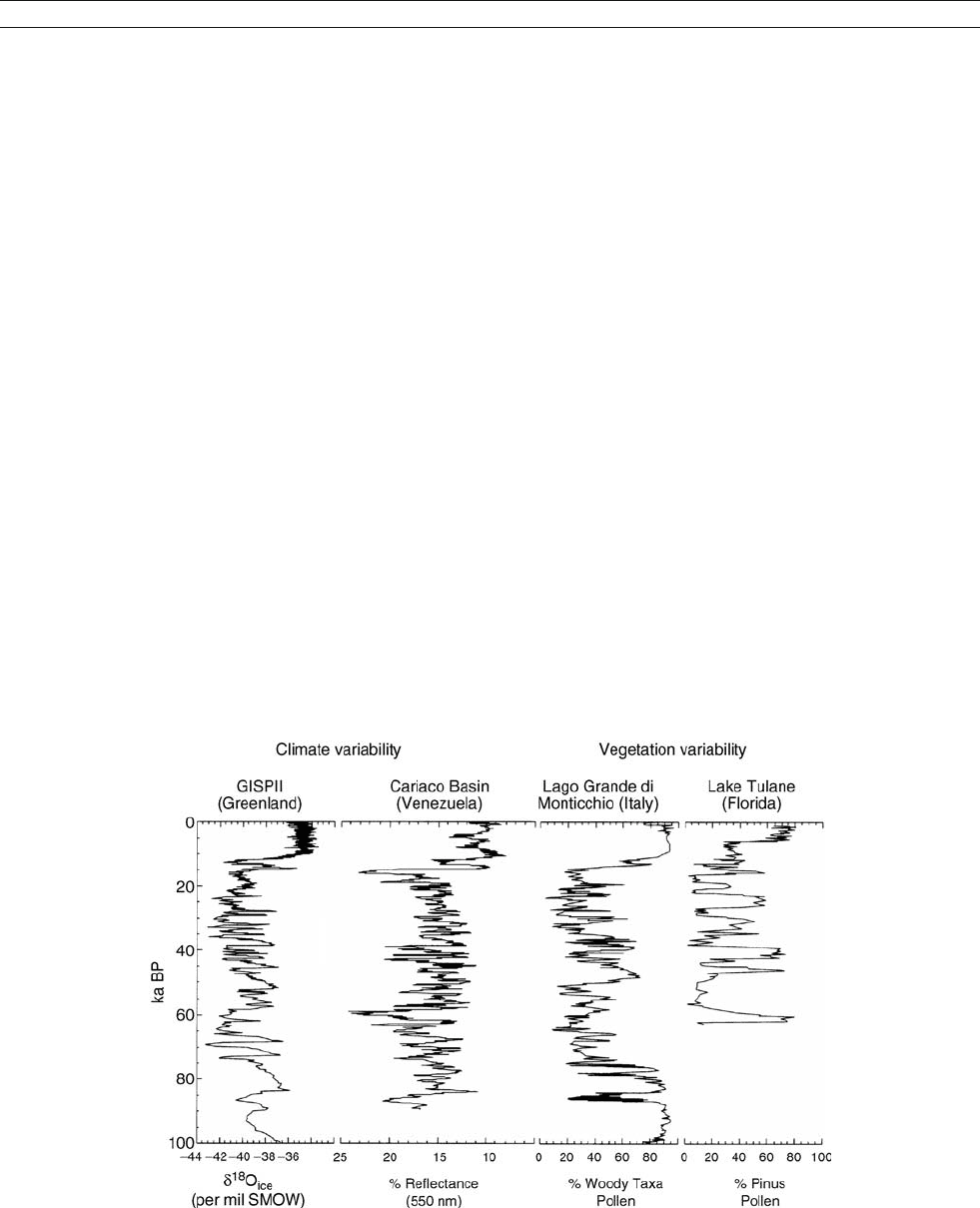
(Imbrie and Imbrie, 1979). One of the findings of the CLIMAP
ocean reconstructions was that ice age tropical SSTs did not fall
greatly relative to the present. However, since then it has been
shown that tropical SSTs were considerably cooler than at present.
Continental reconstructions, however, lagged behind because of
the fragmental nature of the record, often of insufficiently high
quality. Indeed, land-sea correlations remain as one of the greatest
challenges.
Some of the earliest land-sea correlations were between
marine oxygen isotope stratigraphy and the loess sequences
of Central Europe and China. Ice ages were indicated by loess
deposition in arid environments and interglacials were indi-
cated by soil development. The long loess sequences in China,
as well as those offshore in the North Pacific, show that atmo-
spheric dust was an important component of the changing cli-
mate system.
Better and longer pollen sequences on the continents
questioned earlier precepts: for example, it was shown that
temperate forest did not exist during the last ice age in the
Mediterranean but instead steppic plant communities were
extensive, with temperate forest survival in Balkan and Greek
plant refugia. More significantly, much of the tropics and
sub-tropical regions were shown to be arid rather than, as pre-
viously thought, wetter places. This compelled a review of the
climate system and the role of the Hadley-Walker cells, the
trade winds and Intertropical Convergence Zone (ITCZ) in a
drier and cooler ice age world. The pollen record from some
long lake sequences, for example in Greece, Colombia and
Lake Baikal in Asia, matched the deep sea record and con-
firmed that Pleistocene vegetation patterns pulsed primarily to
the orbital beat as the result of changing seasonality and insola-
tion. The 41,000-year obliquity forcing was dominant at mid to
high latitudes, especially in influencing ice sheet growth and
decay, whereas precession (23,000 and 19,000 years) was
dominant at lower latitudes.
Although much is now known about the last glacial cycle,
aided to a large extent by the availability of
14
C ages for the
past 40,000 years, relatively little is known in detail before
the last interglacial (oxygen isotope sub-stage 5e or event 5.5
of the marine record). Currently some emphasis is placed on
oxygen isotope stage 11, the interglacial some 400,000 years
ago, because of its orbitally similar configuration to the current
(Holocene) interglacial (Droxler et al., 2003). However, rela-
tively little is known about major continental areas during other
ice ages and interglacials.
Millennial cycles
Although the evidence for sub-orbital pacings had been long
available from the Camp Century drill hole in Greenland
(Dansgaard et al., 1969), it was not until additional ice cores
were recovered that their millennial time scale records were
appreciated, especially the 1,450 or 1,500 year pacing (Alley,
2000; Bond et al., 2001). These Dansgaard-Oeschger (D-O)
cycles, with the warmer events called interstadials and colder
ones stadials, are grouped into saw-toothed packages of
increasing cold that are terminated by rapid warming events.
Rapid changes in temperatures at the surface of the ice sheets
occurred in less than a decade. The pattern of square-wave cli-
mate changes shown by the ice core records is matched by evi-
dence from high sedimentation cores in the North Atlantic of
SSTs inferred from the polar-dwelling foraminifer Neoglobo-
quadrina pachyderma (s.) and oxygen isotope variability
(Bond and Lotti, 1995). The evolution of these cycles has been
Figure P73 Four records showing millennial time scale variability over the last glacial cycle. The Greenland record of oxygen isotope variability
shows the last 10,000 years of the present (Holocene) interglacial with which the warmer climates of the last glacial cycle (interstadials) alternate
with colder ones (stadials). The offshore Cariaco Basin records influxes of minerals (high reflectance) from South America during stadials. In Italy
and Florida, the changing vegetation, inferred from the fossil pollen record, shows similar variability, including cooler climates during Heinrich
events (Overpeck et al., 2003).
PLEISTOCENE CLIMATES 801
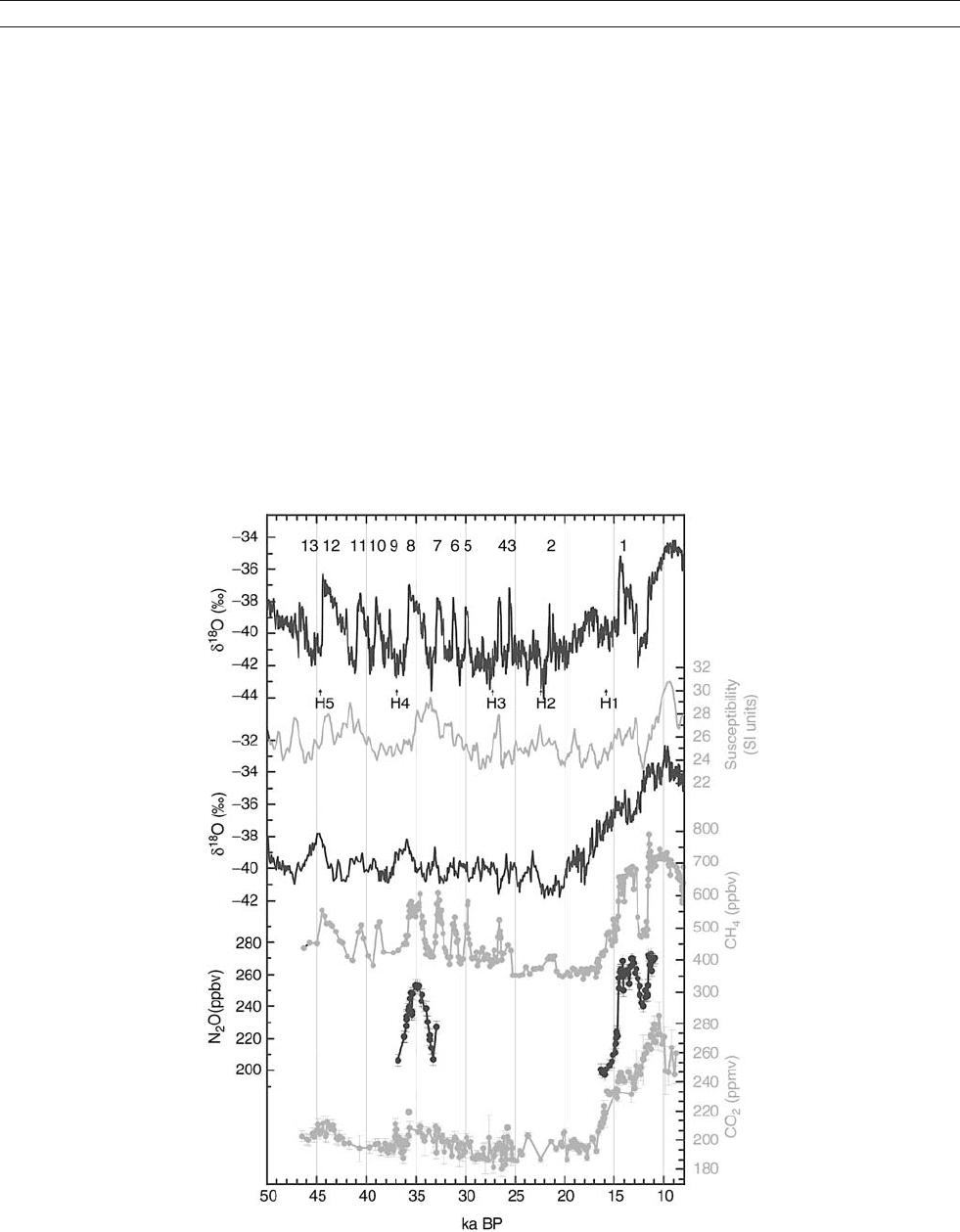
attributed to oscillations in the strength of heat delivery by the
Atlantic thermohaline circulation that caused changing tem-
peratures at the ice sheet surface (Alley, 2000). Others have
pointed to a solar connection because oxygen isotope variabil-
ity in ice cores corresponds with similar variability in the con-
centration of the cosmogenic isotope
10
Be, which indicates
changes in solar irradiance (Rind, 2002). Corresponding with
the rapid warming at the end of Bond Cycles (Bond and Lotti,
1995), layers of ice-rafted debris (IRD), representing “Heinrich
events” occur in marine cores. Deposited from “armadas” of
icebergs discharged into the North Atlantic (Broecker, 1994;
Bond and Lotti, 1995), IRDs indicate collapse and surging of
ice sheets into the tidewater zone. Because they do not corre-
spond with every D-O package of events, it is likely they were
partly forced by climate, but only occurred when appropriate
glaciological conditions for collapse and surging existed.
Greenland and Antarctic ice cores contain bubbles of air
from which the near-contemporary concentrations of atmo-
spheric greenhouse gases (CO
2
and CH
4
) can be measured
(Alley, 2000). Spikes of CH
4
provide a means of correlation
of the oxygen isotope temperature record between Greenland
and Antarctica and allow phase relationships between the
Northern and Southern Hemisphere polar regions to be
explored. The pattern of greenhouse gas variability pulsed on
both orbital and millennial time scales. When correlated
with other evidence, they confirm previous inferences of
a cooler and more arid Earth during the ice ages, with relatively
lower atmospheric concentrations (180 ppm) of carbon diox-
ide, and warmer interglacial conditions with relatively higher
( 280 ppm) concentrations.
Further evidence that all the Earth’s systems pulsed at mil-
lennial timescales is available from a wide range of environ-
ments that show that atmospheric patterns changed rapidly:
for example, in the lake systems of western North America,
and monsoonal climates in India, Asia and South America
(Clark et al., 2001). Figure P73 (Overpeck et al., 2003) shows
the GISP2 (Greenland Ice Sheet Project 2) d
18
O temperature
signal with packages of D-O pacings that end with a rapid
warming. These pacings at 1,450 years continue, with reduced
amplitude, into the present (Holocene) interglacial (Bond et al.,
2001). The reflectance characteristics of sediments from the
Cariaco Basin, offshore of Venezuela, record major changes
in the hydrologic systems of the tropical Atlantic. Increased
precipitation and river discharge from northern South America
Figure P74 Greenland and Antarctic ice core records and Loess in China show millennial pacing for variability in temperature,
carbon dioxide, methane, nitrous oxide and the East Asian monsoonal over the past 50,000 years (from Raynaud et al., 2003).
802 PLEISTOCENE CLIMATES

correspond with interstadial (warmer) events, which suggests
higher moisture fluxes from the Atlantic to the Pacific, inter-
spersed with lower precipitation (light colored sediments) as
the Intertropical Convergence Zone migrates south during
colder stadials. Note the rapid changes in vegetational stability
in Italy and Florida that are correlated with D-O events.
Figure P74 shows millennial scale changes from different
sources (Raynaud et al., 2003). From top to bottom: tempera-
ture variability as shown by the Greenland (GRIP) oxygen iso-
topic record; record of the Asian summer monsoon from
magnetic susceptibility of Chinese loess, peaks indicate times
of strong monsoons; temperature variability as shown by the
Antarctic (Byrd station) oxygen isotope record; the methane
record from Greenland; the N
2
O record from Greenland; and
the CO
2
record from Antarctica (Byrd station). Note that the
Greenland and Antarctic records have been correlated by global
methane spikes. Numbers 1–13 indicate Dansgaard-Oeschger
(D-O) events in the Greenland record, while H1–H5 indicate
Heinrich events.
Clearly, different sub-systems that were widely separated
pulsed at the 1,450 pacing. Millennial variability at a global
scale shows that climate signals are transmitted rapidly
throughout the entire system. However, is this compatible with
heat distribution by ocean thermohaline circulation? To what
extent does the atmosphere play a role in the advection of heat
and moisture from low latitude tropical oceans, notably the
Pacific Ocean (Cane and Clement, 1999)?
Sub-millennial changes
Some of the answers to the questions raised above may
come from records of sub-millennial changes in climate on
inter-decadal or inter-annual timescales of physical annular
modes of variability. These include records of the transfer of
heat and moisture by Indian, African and Asian monsoons, El
Niño (ENSO), North Atlantic Oscillations (NAO), Arctic
Oscillation and Antarctic Oscillation. These are all intercon-
nected in transporting heat from tropical oceans to higher lati-
tudes. Their teleconnections are complex and may be driven
in part by variability in solar irradiance as well as eccentri-
city-modulated precession. Cane and Clement (1999) have sug-
gested that scaling El Niño (ENSO) events may well provide
explanations for variability in large-scale Pleistocene climates.
This may also account for the “stage 11 problem,” the appar-
ently disproportionate response of the climate system to weak
eccentricity forcing. Perhaps low eccentricity may dampen pre-
cessional variability and concentrates heat in the low latitude
tropical belt from where it is advected polewards.
Although there seems little doubt that discharges of fresh-
water from the Laurentide Ice Sheet influenced thermohaline
activity in the North Atlantic Ocean during ice ages (Clark
et al., 2001), it is otherwise undeniable that the concept of the
North Atlantic, Greenland and Norwegian Seas’ thermohaline
influence in redistributing heat is under challenge from the tro-
pical Pacific as the main source of heat and moisture. Thus,
65
N, the “critical latitude” of Milutin Milankovitch, and the
ocean thermohaline circulation climate signal carrier is chal-
lenged by data from the tropical Pacific Ocean.
This debate has rejuvenated the climatologic-paleoclimate
link in the search for mechanisms of abrupt and rapid change
for Pleistocene climates. Increasing interest in solar irradiance
variability is the result of ongoing physical measurements as
well as the record of variability inferred from cosmogenic iso-
tope abundances in ice cores. The not-unrelated role of cosmic
particles may also have a bearing on the elusive role of cloud
and water vapor in climate variability on different timescales.
Concepts of Pleistocene climates have been revolutionized in
less than half a century and, while the Pleistocene past may
hold a key to the present and future, its reciprocal, of the pre-
sent being the key to the past, remains undiminished.
David Q. Bowen
Bibliography
Alley, R.B., 2000. The Two-Mile Time Machine: ice cores, abrupt climate
change, and our future. Princeton: Princeton University Press, 229pp.
Bond, G.C., and Lotti, R., 1995. Iceberg discharges into the North Atlantic
on millennial timescales during the last glaciation. Science, 267,
1005–1010.
Bond, G., Kromer, B., Beer, J., Muscheler, R., Evans, M.N., Showers, W.,
Hoffmann, S., Lotti-Bond, R., Hajdas, I., and Bonani, G., 2001. Persis-
tent solar influence on North Atlantic climate during the Holocene.
Sience, 294, 2130–2136.
Broecker, W.S., 1994. Massive iceberg discharges as triggers for global cli-
mate change. Nature, 372, 421–424.
Broecker, W.S., and Denton, G.H., 1989. The role of ocean-atmosphere
reorganizations in glacial cycles. Geochim. Cosmochim. Acta, 53,
2465–2501.
Cane, M., and Clement, A.C., 1999. A role for the Tropical Pacific Coupled
Ocean-Atmosphere System on Milankovitch and Millennial Timescales:
Part II: Global Impacts. In Clark, P.U., Webb, R.S., and Keigwin, L.D.
(eds.), Mechanims of Global Climate Change at Millennial Time Scales.
Washington, DC: American Geophysical Union, pp. 373–384.
Clark, P.U., Marshall, S.J., Clarke, G.K.C., Hostetler, S.W., Licciardi, J.M.,
and Teller, J.T., 2001. Reshwater forcing of abrupt climate change dur-
ing the last glaciation. Science, 293, 283–287.
Cronin, T. M., 1999. Principles of Paleoclimatology, New York: Columbia
University Press, 560pp.
Dansgaard, W.S., Johnsen, S.J., Møller, J., and Langway, C.C., 1969.
One thousand centuries of climatic record from Camp century on the
Greenland Ice Sheet. Science, 166, 377–380.
deMenocal, P., 1995. Plio-Pleistocene African climate. Science, 270,
53–59.
Droxler, A., Poore, R.Z., and Burkle, L.H., 2003. Earth’s Climate and
Orbital Eccentricity: The Marine Isotope Stage 11. Washington, DC:
Geophysical Monograph, American Geophysical Union.
Imbrie, J., and Imbrie, K.P., 1979. Ice Ages: Solving the Mystery. London:
Macmillan, 224pp.
Overpeck, J.T., Whitlock, C., and Huntley, B., 2003. Terrestrial biosphere
dynamics in the climate system: Past and future. In Alverson, K.D.,
Bradley, R.S., and Pederson, T.F. (eds.), Paleoclimate, Global Change
and the Future. Berlin: Springer, pp. 82–103.
Rind, D., 2002. The Sun’s Role in Climate Change. Science, 296, 673
–677.
Raynaud, D., Blunier, T., Ono, Y., Delmas, R., Barnola J.M., Joos, F.,
Petit, J.R., and Spahni, R., 2003. The late Quaternary history of atmo-
spheric trace gases and aerosols: Interactions between climate and bio-
chemical cycles. In Alverson, K.D., Bradley, R.S., and Petersen, T.F.
(eds.), Paleoclimate, Global Change and the Future. Berlin: Springer,
13–32.
Zahn, R., 2002. Milankovitch and Climate: the Orbital Code of Climate
Change. JOIDES J. (Special Issue), 28,17–22.
Cross-references
Aerosol (mineral)
Albedo Feedbacks
Alkenones
Arid Climates and Indicators
Astronomical Theory of Climate Change
Atmospheric Circulation During the Last Glacial Maximum
CLIMAP
Climate Change, Causes
Cosmogenic Radionuclides
Dansgaard-Oeschger Cycles
Eccentricity
PLEISTOCENE CLIMATES 803

Foraminifera
Glaciations, Quaternary
Heat Transport, Oceanic and Atmospheric
Heinrich Events
Human Evolution and Climate Change
Ice Cores, Antarctica and Greenland
Ice-Rafted Debris (IRD)
Interstadials
Lake Level Variations
Last Glacial Maximum
Laurentide Ice Sheet
Little Ice Age
Loess Deposits
Millennial Climate Variability
Moraines
Monsoons, Quaternary
North Atlantic Deep Water and Climate Change
North Atlantic Oscillation (NAO) Records
Obliquity
Ocean Paleotemperatures
Oxygen Isotopes
Paleo-El Niño-Southern Oscillation (ENSO) Records
Paleoceanography
Paleotemperatures and Proxy Reconstructions
Pliocene Climates
Pollen Analysis
Precession, Climatic
Quaternary Climate Transitions and Cycles
Quaternary Vegetation Distribution
Sea Level Change, Quaternary
SPECMAP
Stable Isotope Analysis
Sun-Climate Connections
Thermohaline Circulation
Time-Series Analysis of Paleoclimate Data
Transfer Functions
Uranium-Series Dating
Wisconsinan (Weichselian, Würm) Glaciation
PLIOCENE CLIMATES
Introduction
The Pliocene (Plio More – Cene Recent) epoch represents the
uppermost sub-division of the Tertiary period. It spans a time-
frame from 5.3 to 1.8 million years before present, according
to the geological timescale of Berggren et al. (1995). The epoch
incorporates the time interval in which Earth experienced a
transition from relatively warm climates to the prevailing
cooler climates of the Quaternary period.
Climatically, the Pliocene can be crudely divided into three
phases, (a) an Early Pliocene warm period, (b) a relatively
short-lived ‘warm blip’ during the middle part of the Pliocene
(centered around 3 million years before present), and (c) a cli-
matic deterioration during the late Pliocene. It is important to
realize that available higher resolution climate records for this
time (e.g., Leroy and Dupont, 1994) suggest that even rela-
tively short subdivisions of the epoch were characterized by
almost continuous changes in precipitation and temperature,
occurring on the timescale of several thousand years. This cli-
matic variability is poorly resolved in terms of magnitude
(Haywood et al., 2002a) but often occurred with detectable per-
iodicities of 41,000 and 19,000, 21,000 and 23,000 years,
linked to obliquity and precessional Milankovitch cycles (cyc-
lic variations of the Earth’s orbital position; obliquity is the
angle of Earth’s axial tilt as measured against the plane of the
ecliptic; precession is the degree of wobble of the Earth on its
axis, which is caused by the gravitational pull of the Sun and
the Moon). It is likely that many abrupt, short timescale climate
events currently remain undetected due to the lack of high reso-
lution and long paleoclimatic records, thus making the process
of generalization regarding the climate of the Pliocene extre-
mely hazardous.
Even though a progressive cooling was occurring during the
Tertiary, the Pliocene world appears to have been, for the most
part, warmer than at present. The ancient distribution of plank-
tonic (free-floating marine organisms) and benthic (bottom-
dwellers) foraminifer (minute aquatic organisms that consist
of a single cell or a colonial aggregate of cells without differen-
tiation of function) along with terrestrial fossil fauna and flora,
indicates that mean annual temperatures in the mid-latitudes
were often several degrees higher (3
Cto5
C) than at present
(e.g., Thompson, 1991; Dowsett et al., 1996). The greatest
warming appears to have been in the high latitudes and polar
regions, where temperatures were often warm enough to allow
species of animals and plants to exist at higher latitudes than
their nearest modern relatives (Adam, 1994).
The recognition that significant warming took place at high
latitudes and at the poles has interesting implications for the
behavior and extent of sea ice, the major terrestrial ice sheets
of Greenland and Antarctica, and for Pliocene sea levels.
Sea ice
Diatom (see Diatoms) data from the Southern Ocean (Barron,
1996), and foraminifer, ostracod (see Ostracodes) and mollusk
(invertebrate of the phylum Mollusca) data (Cronin et al.,
1993) suggest that sea ice extents were greatly reduced at
approximately 3 million years before present, with modern
summer sea-ice limits similar to Pliocene winter sea-ice cover
and the possibility that the Arctic Ocean was seasonally sea-
ice free (Cronin et al., 1993).
Ice sheets
Significant debate has centered on the nature of the terrestrial
ice sheets of Greenland and Antarctica during the Pliocene.
The consensus view, through examination of ice-rafted detritus
(IRD) in marine sediment cores (e.g., Kleiven et al., 2002), is
that the initiation of significant Northern Hemisphere glaciation
began during the middle to late Pliocene. However, there may
have been many false starts to this glaciation, with evidence
existing for glacial activity on Greenland as far back as the late
Miocene. Total ice volume on Greenland may have remained
significantly less than at present even during the latter parts
of the Pliocene epoch.
With regard to Antarctica, two contrasting viewpoints exist.
The first, based on evidence derived from Pliocene marine
diatoms (Harwood and Webb, 1986) and the remains of
Nothofagus (Southern Beech) in the Sirius Group glacial
sediments along the Transantarctic Mountain Range (Francis
and Hill, 1996), suggests that the East Antarctic Ice Sheet
(EAIS) may have been significantly reduced in size (by a max-
imum of one-third). The second, based on geomorphic investi-
gations of the landscape in the Dry Valleys region, suggests
that stable polar conditions have persisted for at least the last
14 million years (Denton et al., 1993). The dating of a variety
of landforms including superficial till sheets, old desert pave-
ments, avalanche deposits and volcanic ash layers that span
the Miocene and Pliocene apparently testify to remarkably slow
804 PLIOCENE CLIMATES
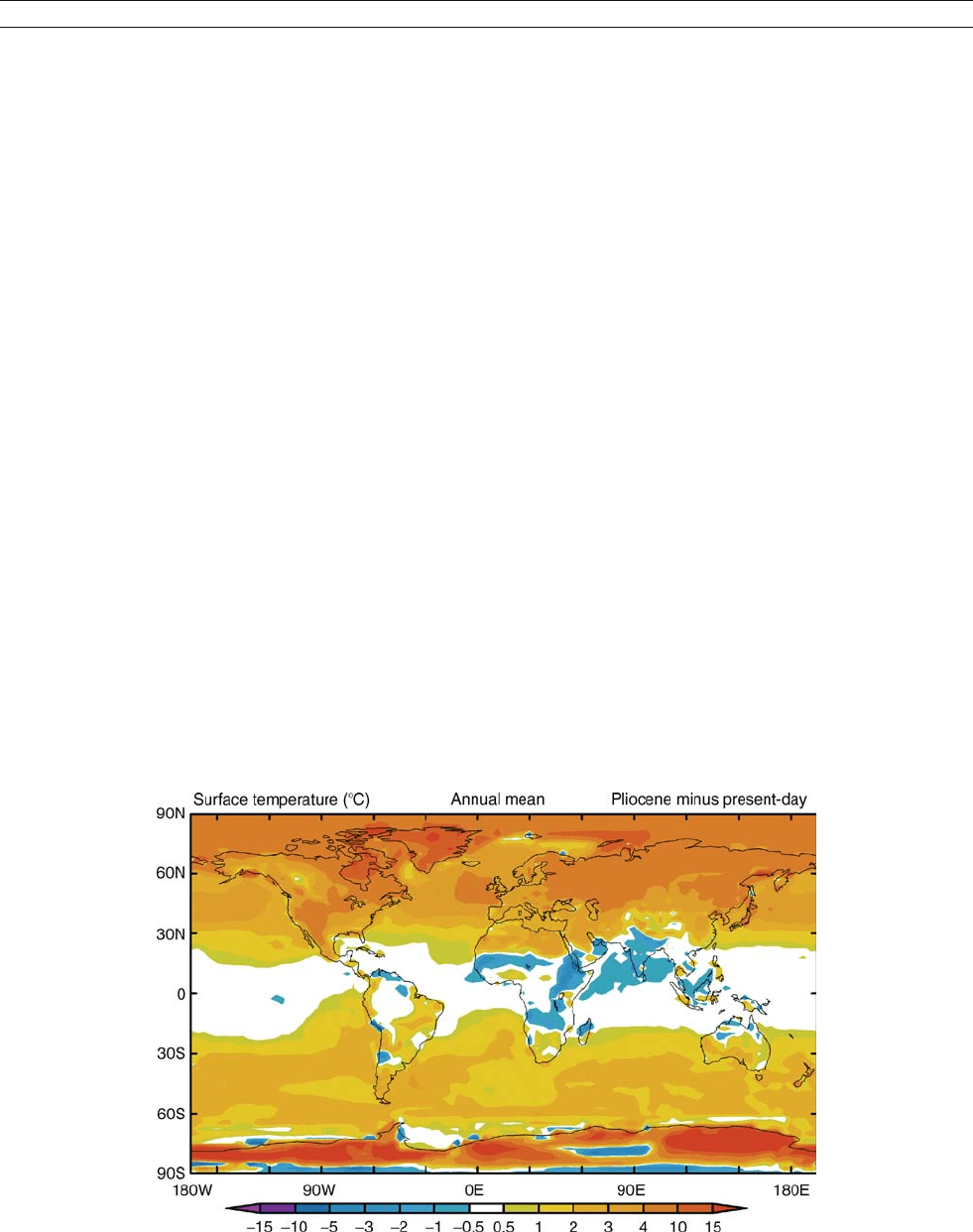
rates of weathering and erosion in the Dry Valleys (Marchant
et al., 1993). If the EAIS did behave in a dynamic manner, it
is unlikely that such geomorphic features, if truly Miocene or
Pliocene in age, would have survived.
Sea level
If terrestrial ice cover was reduced during the Pliocene, then glo-
bal sea levels should also have been higher than at present. Evi-
dence exists which indicates that sea levels were higher,
although the potential errors in the data make it difficult to assess
the true magnitude of sea-level change. Based on sequence stra-
tigraphic techniques, sea-level highstands of up to 60 m were
reported by Haq et al. (1987). Dowsett and Cronin (1990) used
the presence of the Orangeburg Scarp (an extensive paleoshore-
line from the southeastern U.S. Atlantic Coastal Plain) com-
bined with micropaleontological evidence to suggest that a
sea-level highstand of approximately 35 18 m higher than pre-
sent existed between 3.5 and 3.0 million years before present.
The stratigraphic distribution of disconformities (type of uncon-
formity where the buried erosion surface lies between two series
of strata that are parallel on a large scale) at Enewetak Atoll sug-
gests a Pliocene sea level 36 m higher than today’s (Wardlaw
and Quinn, 1991). Through the analysis and correlation of
Atlantic Coastal Plain sediments with d
18
O (see Oxygen iso-
topes) isotopic records from deep-sea cores, sea levels between
4.0 to 3.5 million years ago and 3.0 million years ago have been
estimated as 30–35 and 25 m higher than modern, respectively
(Krantz, 1991). These sea-level changes appear to have been dri-
ven by glacio-eustatic events (see Glacial eustasy), but their pre-
cise correlation to changes in the polar regions remains unclear
(Dowsett et al., 1996).
Climate dynamics and climate modeling
The use of numerical climate models, or General Circulation
Models (GCMs), is one of the most powerful tools at our
disposal for the investigation of past climate dynamics. Numer-
ous climate modeling studies have been conducted for the Plio-
cene using a host of different models of varying sophistication
(see Mid-Pliocene warming this volume; Chandler et al., 1994;
Sloan et al., 1996; Haywood et al., 2000a,b; Kim and Crowley,
2000; Haywood, 2001; Haywood et al., 2001; Haywood et al.,
2002a,b,c; Haywood and Valdes, 2004). The focus of these
modeling studies has been on the period of warming which
occurred around 3 million years before present. This is primar-
ily due to the wealth of geological and boundary condition data
sets (necessary for the initiation of the climate model experi-
ments) that exist for this period (see Dowsett et al., 1999).
Climate modeling – surface temperat ure (
C)
Atmosphere-only climate model studies (experiments that do
not include an interactive ocean model in any form) suggest
that the climate of 3 million years before present was, as a
global annual average, 2 to 5
C warmer than at present (Sloan
et al., 1996; Haywood et al., 2000a; see Figure P75). Three
zones of temperature change were predicted in the climate
modeling study of Haywood et al. (2000a). Between 10
and
30
North and South of the equator, the predicted warming
was a modest 1 to 4
C. Between 30
and 50
in the Northern
Hemisphere, temperatures warmed by 4–8
C. This pattern
was not duplicated in the Southern Hemisphere, where the
temperature rise was 0–4
C. By far the greatest relative
warming was indicated at latitudes above 70
in both hemi-
spheres (Figure P76). Temperature changes relative to present
in high latitude areas of the Northern Hemisphere during the
winter period (December, January and February; DJF) ranged
from 16–20
C in Greenland to 20–28
C in the Arctic. During
DJF (Southern Hemisphere summer), dramatic warming in
parts of west and east Antarctica (~32–36
C) was predicted.
During June, July and August (JJA), Antarctica warmed in a
Figure P75 Climate model prediction: difference between simulated Pliocene (3 million years before present) and present-day surface temperature
(
C) as an annual mean (redrawn from Haywood et al., 2000a; Haywood, 2001). Model used was the Hadley Center Atmospheric Climate
Model Version 3 (HadAM3), boundary conditions specified from the PRISM2 data set (Dowsett et al., 1999).
PLIOCENE CLIMATES 805
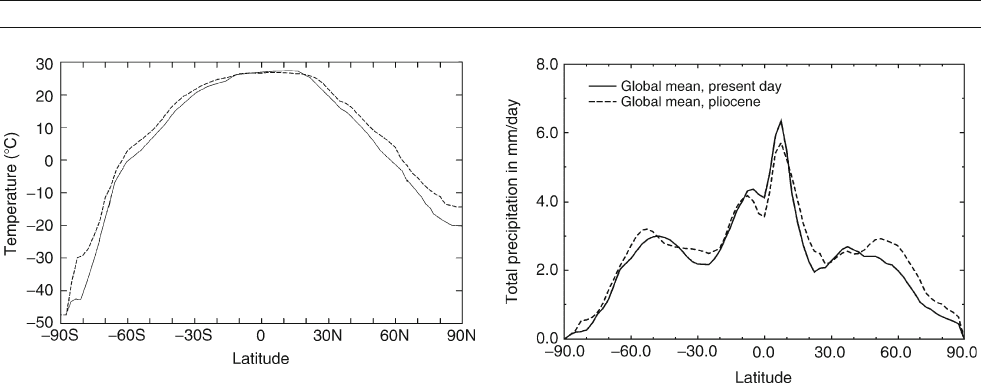
comparable fashion to the DJF period (20–32
C). However,
the warming occurred over a significantly wider area of the
continent.
The pattern of temperature change was not spatially uniform.
During DJF, a zone of discontinuous cooling (maximum of 4
C)
was predicted from 10
North to 10
South of the equator; this
extended over parts of northern Australia and South America.
During JJA, the equatorial/low latitude belt of cooling became
more continuous, especially over parts of Africa and southern
Asia. Temperatures in parts of Africa at 10
North of the equator
cooled by 4 and 8
C as compared to the present.
The predicted high latitude warming (>70
North and South)
can be attributed to a reduction of ice cover in both oceanic and
terrestrial settings during the Pliocene and to the prescribed war-
mer high latitude sea surface temperatures (SSTs). Furthermore,
the significance of a higher Pliocene sea level should not be
underestimated. Oceans cool less than land when exposed to
cold conditions, so higher sea levels act as a positive feedback
mechanism for temperature, especially in the high latitudes
(Sloan et al., 1996). The equatorial and low latitude cooling is
due to more than one contributing factor. SST values for the
oceans in equatorial and low latitudes are likely to have an
effect, as are variations in cloud cover and vegetation in these
areas. Increased precipitation promoting greater evaporation in
this region acts as a cooling feedback. This is probably the main
cause of the tropical cooling observed over Africa.
The GCM indicated that the greatest degree of warming
occurred in the Northern and Southern Hemisphere during their
respective winter seasons. This is attributable to the warmer
SSTs in the mid to high latitudes, with associated changes in
snow and ice cover.
Climate modeling – total precipitation rate (mm day
–1
)
The distribution of total precipitation during the Pliocene was
simulated in Haywood et al. (2000a) and Haywood (2001)to
be broadly similar to present (Figure P77). A general but modest
increase, of between 0 and 2 mm day
–1
, was predicted in both
hemispheres during DJF and JJA. Although sporadic pockets
of less rainfall (–2 mm day
–1
) were common, especially during
JJA, they were frequently not statistically significant. Annual
mean precipitation during the Pliocene was 34.65 cm year
–1
,
2 cm higher than at present (32.84 cm year
–1
), representing a
6% increase relative to modern values (Figure P77). During
DJF in the Northern Hemisphere (10
–70
North), areas of
enhanced precipitation were noted (Figure P78). These areas
include the Indian Ocean, the Caribbean, the North Atlantic
and northwestern North America, where precipitation was
enhanced by 2–8 mm day
–1
. The increase in mid-latitude preci-
pitation in the Northern Hemisphere was associated with the
warmer surface temperatures.
Increases in precipitation during JJA were seen to occur in a
narrow belt at equatorial and low latitudes. India, Arabia,
Central and West Africa, the Caribbean and the West Coast
of Central and Latin America all showed an increase in preci-
pitation of between 2 and 10 mm day
–1
(Figure P78). The model
indicated that the southern limit of the Hadley Cell (atmospheric
cell which transports heat and momentum in the atmosphere at
low-latitudes) was in approximately the same position as at pre-
sent. However, the northern limit was shifted further to the North
by 5
of latitude. The result was a net ‘broadening’ of the Hadley
Cell in the Pliocene, which allowed more precipitation to fall
over a larger geographical area. This change in the Hadley Cell
was caused by the simulated reduction in the equator-to-pole
temperature gradient (by 6
C). Broadening of the Hadley Cell
explained several of the model’s responses observed at equatorial
and low latitudes, such as increased precipitation, evaporation
and subsequent reduction of surface temperatures.
Over Greenland, a statistically significant increase in preci-
pitation was predicted, except over the southern tip of Green-
land where precipitation decreased. This decrease was related
to a shift in the position of the Atlantic storm track.
Climate modeling – wind (m s
–1
) and surface
pressure (hPa)
As a global annual average, surface wind strength decreased
in the Pliocene experiment compared to the present. This res-
ponse was consistent with the model-predicted reduction in
the equator-to-pole temperature gradient of 6
C, which dimin-
ished the general circulation of the atmosphere. Most variations
in wind dynamics were observed in the westerly component.
In the simulation, Pliocene wind directions were broadly
similar to the present. Increases in wind speed were observed
Figure P76 Model-predicted Pliocene (dashed line) and present-day
(solid line) mean annual surface temperatures (
C) plotted as a function
of latitude. This plot indicates a surface temperature regime with
reduced seasonality and greater equability during the Pliocene
compared to present-day (Haywood, 2001).
Figure P77 Annual mean total precipitation rate as a function of
latitude for present-day and the Pliocene in mm day
–1
(redrawn from
Haywood et al., 2000a; Haywood, 2001).
806 PLIOCENE CLIMATES
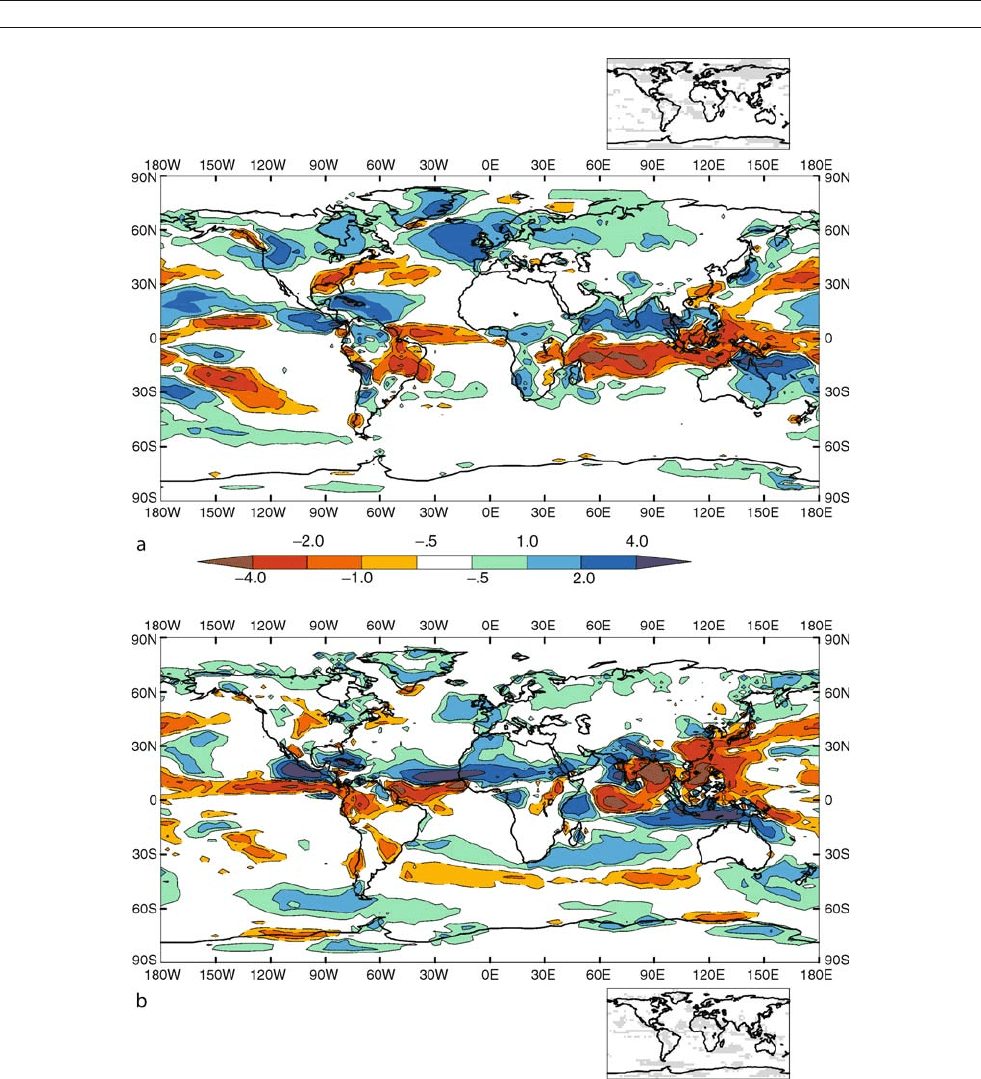
over areas of North America, Siberia and the Tibetan Plateau.
This was a function of the altered land cover and surface heat-
ing characteristics of the Pliocene simulation as compared to
the modern one. Wind strengths over the oceans exhibited a
more dramatic change in the Pliocene scenario. Wind speeds
increased by a maximum of 6 m s
–1
during DJF in areas
affected by the Icelandic and Aleutian low-pressure systems.
These pressure systems deepened in the Pliocene simulation
as compared to the present (Figure P79).
Analysis of wind strength fields at 200 mbs indicated that the
strength of the mid-latitude jet streams was enhanced in the Plio-
cene experiment. Increases in wind speeds in other locations
Figure P78 Model-predicted difference in mean total precipitation rate (mm day
–1
) between the Pliocene and present-day for (a) DJF and
(b) JJA. Note that the contour interval is not equally spaced and regions where precipitation change is less than 0.5 mm day
–1
are unshaded. The
grey shading in accompanying mini-boxes shows the geographical areas in which the difference in precipitation rate is significant to a 95%
statistical significance level (redrawn from Haywood et al., 2000a; Haywood, 2001).
PLIOCENE CLIMATES 807
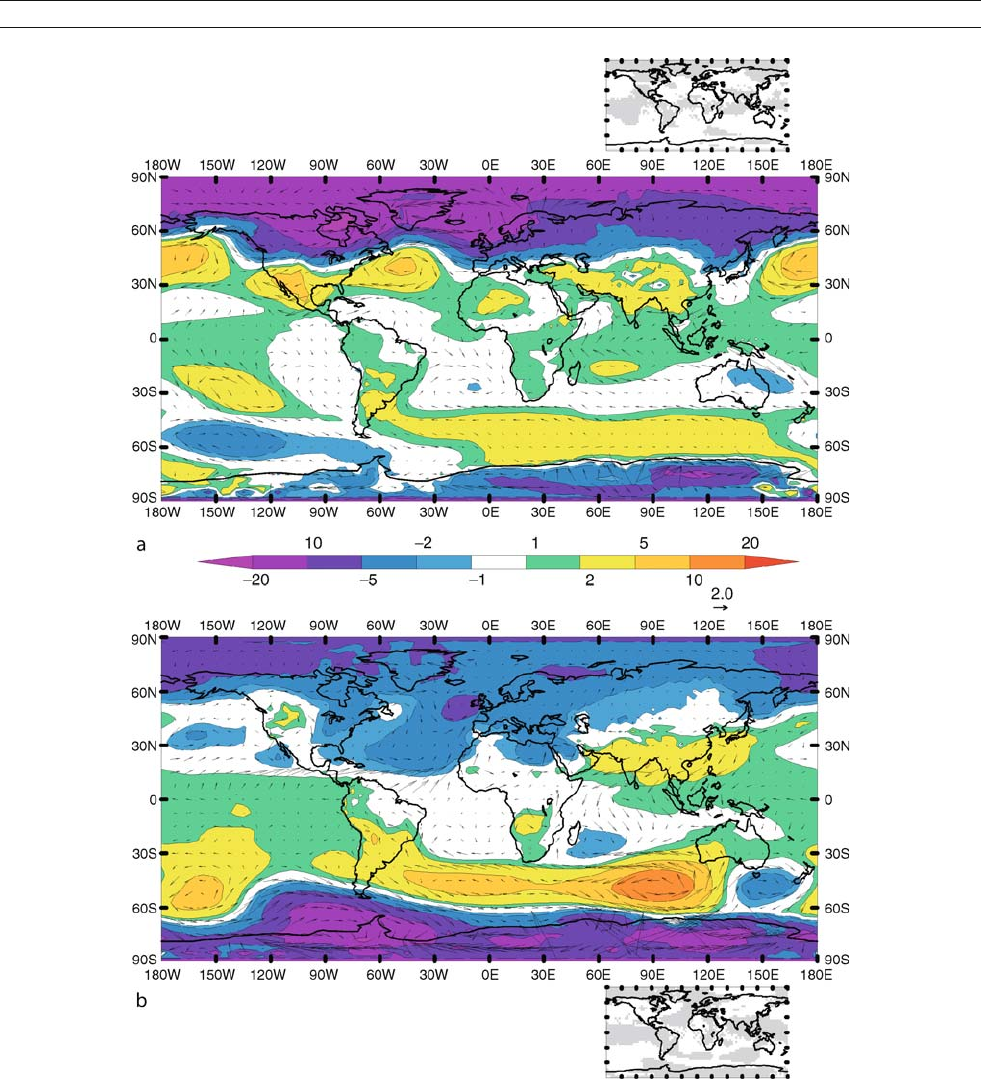
were accounted for by the enhancement of high-pressure zones
over subtropical ocean regions. A strong high-pressure anomaly
was observed in the Southern Ocean west of Australia during
DJF and JJA (Figure P79). This was related to alterations in
Rossby wave (planetary wave) propagation caused by changes
in the Antarctic orography in the Pliocene simulation. The
strength of JJA monsoon circulation in the Indian Ocean was
weakened in the Pliocene experiment.
Climate modeling summary
The results of the modeling study by Haywood et al. (2000a)
and Haywood (2001) are closely linked to, and dependent
Figure P79 Model-predicted difference in surface pressure (hPa) between the Pliocene and present-day for (a) DJF and (b) JJA: Vector
surface mean winds are also shown. The grey shading in accompanying mini-boxes shows the geographical areas in which the difference in
precipitation rate is significant to a 95% statistical significance level (redrawn from Haywood et al., 2000a; Haywood, 2001).
808 PLIOCENE CLIMATES

on, the specified model boundary conditions. From analysis of
the model simulation and from sensitivity experiments
(Haywood, 2001), it is clear that alterations in SSTs combined
with sea and land ice volumes within the model boundary con-
ditions are primarily responsible for the observed variations
between Pliocene and present-day climates. The variations in
climate are caused by the alteration of processes, including
the release of sensible and latent heat (SST driven) and by
variations in heat exchange between the ocean and atmosphere
that are also caused by differences in sea ice.
The warmer SSTs are responsible for the majority of model-
predicted annual mean increase in surface temperatures and pre-
cipitation for the Pliocene. However, changes in high latitude
surface temperatures and precipitation rate are also closely linked
to the altered configuration of terrestrial ice sheets and sea-ice
extents specified within the model boundary conditions. The
enhancements of the mid-latitude jet streams and surface wes-
terly winds predicted in the Pliocene experiment are primarily
linked with changes in atmospheric pressure systems, which
are themselves generated by reduced high latitude terrestrial
and sea-ice cover. The role of altered jet stream flow, in response
to the altered orography of the western cordillera of North Amer-
ica, may also be important in generating the enhancements in
westerly wind strength observed in the Pliocene simulation.
Causes of pliocene climate change
Climatic warmth
The causes of Pliocene climate change have been widely dis-
cussed (e.g., Raymo et al., 1996 ). The applicability and scien-
tific usefulness of the question “what was the cause of
Pliocene warmth?” is arguable. This is because of (a) the multi-
ple interactions of different components of the Earth’s climate
system, (b) equifinality (different climate forcing mechanisms
leading to the production of a similar response in climate),
and (c) climatic memory effects (the existence of a global cli-
mate regime at any one time depends not only on forcing
mechanisms in operation during the said regime but also those
which occurred previously). A more scientifically useful ques-
tion to pose might be “what were the processes that helped pro-
mote, sustain and ultimately terminate the climates of the
Pliocene?”. Such an approach has the advantage of being pro-
cess rather than causation driven, which increases the useful-
ness of studying past warm periods in our quest to better
understand future climate change.
Atmospheric CO
2
Estimates of atmospheric CO
2
levels have been derived from
analyses of the stomatal density of fossil leaves (stomata are
small pores on a leaf surface that allow carbon dioxide to enter
the leaf and oxygen to escape, thereby facilitating photosynth-
esis; Kürschner et al., 1996), through analyses of d
13
C ratios of
marine organic carbon (Raymo and Rau, 1992) and through
measurement of the differences between the carbon isotope
composition of surface and deep waters (Shackleton et al.,
1992). Use of all of these proxy methods suggests that absolute
CO
2
levels during the epoch ranged from 360 to 400 ppmv,
compared to mid-nineteenth century levels of approximately
280 ppmv and modern concentrations of 375 ppmv. The cause
for this higher Pliocene concentration is not well understood
and may be attributable to the long-term trend of CO
2
change
throughout the Tertiary (Berner, 1990). Alternatively, feed-
backs between climate and the carbon cycle (the cycling of
carbon in the form of carbon dioxide, carbonates, organic com-
pounds, etc. between various reservoirs, e.g., the atmosphere,
the oceans, land and marine biota and, on geological time
scales, sediments and rocks) may also have been important.
The modest CO
2
increase reconstructed for the Pliocene
would produce a radiative forcing of approximately 2 W m
–2
.
This may be sufficient to explain the warmth of the Pliocene
globally, depending on the chosen climate sensitivity para-
meter, and whether there are any significant changes in other
aspects of the radiative forcing. It cannot explain the regional
changes in reconstructed SSTs, which apparently display no
warming trend relative to present day in the tropics (Dowsett
et al., 1996). Therefore, an additional mechanism (or mechan-
isms) working independently or combined with variations in
CO
2
concentrations in the atmosphere would have been
required to drive and maintain the warmer climates recon-
structed for the Pliocene.
Ocean heat transport
A likely additional factor is a change in the heat transport of
the oceans. This could be achieved through an increase in
thermohaline or surface gyre circulation. This possibility was
highlighted in early modeling studies (e.g., Rind and Chandler,
1991), but many difficulties and unexplained issues remain.
Paradoxically, a reduced latitudinal SST gradient implies wea-
ker atmospheric forcing of surface oceanic circulation, and
hence weaker oceanic heat transport from equator to higher
latitudes. This is a common problem associated with past
warm climate dynamics. Problems exist in any explanation
of Pliocene warmth that is based solely upon strengthening of
the thermohaline circulation as it is, (a) difficult to ascribe a
thermohaline coupling argument to all ocean basins and,
(b) difficult to generate the correct reconstructed hemispheric
temperature distribution (Crowley, 1996).
The arguments above are largely based on a consideration of
global scale energetics. The importance of specific regional
aspects, such as changes in surface wind strength and wind
stress over different ocean basins, has only recently been con-
sidered in detail. Climate modeling results presented in
Figure P79 indicate an increase in westerly component winds
at mid to high latitudes in both hemispheres. This is a direct
response to less ice cover and warmer surface temperatures
over Greenland, the Arctic, Southern Ocean and Antarctica
and to warmer sea-surface temperatures in the North and South
Atlantic Oceans during the Pliocene. Conversely, sub-tropical
high-pressure systems in both hemispheres are also enhanced.
Therefore, regional pressure gradients in the mid to high latitudes
of both hemispheres may have been intensified during the Plio-
cene. This has the potential, when combined with warmer SSTs,
to increase the atmospheric transport of heat and moisture to the
high latitudes (Figure P80). Increasing westerly wind strength
applies greater wind stress (maximum 20 N m
–2
on the basis
of modeling experiments) to the surface of the oceans, thus
potentially strengthening the flow of heat-transporting surface
ocean currents such as the Gulf Stream (Figure P81).
These interpretations, based upon modeling studies (e.g.,
Haywood et al., 2000b), support paleoceanographical evidence
for enhanced oceanic heat transports (e.g., Dowsett et al.,
1996). Enhanced carbonate accumulation and upwelling from
the California margin during the Pliocene relates to increased
wind stress (Ravelo et al., 1997). Results from a study of mar-
ine ostracodes (Cronin, 1991) suggest that: (a) North Atlantic
circulation may have been intensified, and (b) reconstructed
PLIOCENE CLIMATES 809
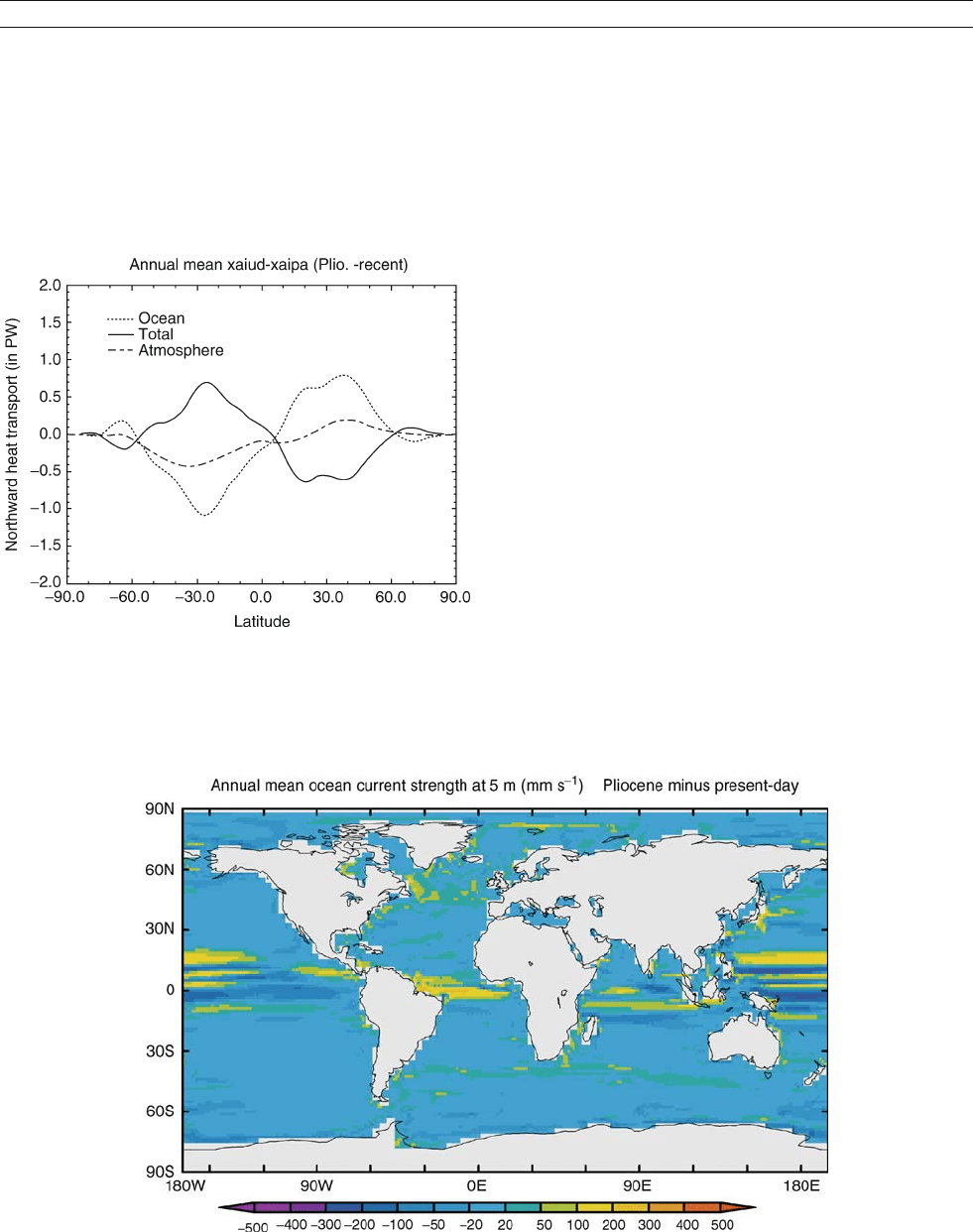
cooler ocean temperatures off the southeastern and mid-
Atlantic coast of the USA during the Pliocene were a result
of enhanced upwelling driven by the Gulf Stream. Billups et al.
(1998) speculated that positive feedbacks involving Southern
Hemisphere atmospheric circulation and Northern Hemisphere
poleward heat transport, together with sea-ice feedbacks, might
have played an important role in maintaining the climatic
warmth of the Pliocene.
Ocean heat transport – difficulties
The mechanism of enhanced ocean heat transport may have
been important in helping to maintain greater mid to high lati-
tude warmth during the Pliocene. However, the oceans act, to a
first approximation, as a feedback mechanism rather than a
direct forcing on climate. In other words, if we invoke greater
oceanic transport of heat to help explain the warmth of the
Pliocene then we must deal with the following question “what
were the factors responsible for forcing a change in oceanic cir-
culation and heat transports?”. Rind and Chandler (1991) pos-
tulated that changes in poleward ocean heat transport might
be related to changes in orography, which would affect the
planetary wind-driven circulation. However, it is unknown
whether changes in orography are capable of affecting wind-
driven circulation on anything more than a regional scale
(Crowley, 1991). Climate modeling sensitivity experiments
conducted by Haywood (2001) indicate that lowering the ele-
vation of the western cordillera of North America, for example,
does have an impact on the surface circulation across North
America and into the Atlantic sector. However, alterations in
high latitude low-pressure and sub-tropical high-pressure cells,
as a result of reduced ice cover and altered SST gradients, are
required to sustain the changes in circulation over the European
and other sectors. Hence, whilst changes in orography may
have been an important contributing factor in forcing changes
in the wind-driven circulation, other mechanisms must have
been in operation to drive larger-scale alterations in oceanic
circulation, for the Pliocene at least.
The potential influence of changing terrestrial ice cover on
oceanic circulation should not be forgotten. Although the direct
effect of reduced high latitude ice cover on surface tempera-
tures may only be observed over a couple of thousand
kilometers away from the ice edge, it can have a significant
impact on atmospheric pressure systems in the mid to high
Figure P80 Model prediction of the difference in total poleward heat
transport (in PW), by atmosphere and oceans between the Pliocene
climate modeling experiment of Haywood et al. (2000a) and the
present-day (xaiud = mid-Pliocene simulation; xajpa = present-day
simulation).
Figure P81 Coupled ocean-atmosphere model prediction of the difference in ocean current strength (mm s
–1
) at 5 m between the Pliocene
and present-day. Note the increase in the strength of the Gulf Stream and North Atlantic Drift currents in the North Atlantic (redrawn from
Haywood and Valdes, 2004).
810 PLIOCENE CLIMATES
